|
|
 |
Fiche d'espèce de Copépode |
|
|
Calanoida ( Ordre ) |
|
|
|
Diaptomoidea ( Superfamille ) |
|
|
|
Pontellidae ( Famille ) |
|
|
|
Labidocera ( Genre ) |
|
|
| |
Labidocera pectinata Thompson & Scott, 1903 (F,M) | |
| | | | | | | Syn.: | Labidocera similis Cleve, 1904 (p.378, figs.F) | | | | Ref.: | | | Thompson & Scott, 1903 (p.235, 252, figs.F); Sewell, 1912 (p.354, 370, figs.F, Rem.); 1914 a (p.236); 1932 (p.372, figs.M, Rem.); 1933 (p.28); 1948 (p.324); Kasturirangan, 1963 (p.50, 51, figs.F,M); Saraswathy, 1966 (1967) (p.81); Pillai, 1971 (p.66, figs.F,M, Juv. 1-5, Rem.); Silas & Pillai, 1973 (1976) (p.808, figs.F,M, Rem.); Goswami & Goswami, 1974 (p.109, fig. caryotypes); Fleminger & al., 1982 (p.262, Rem., figs.F,M); Mulyadi, 2002 (p.p.59, Table 2); Othman & Toda (2006, p.312, figs.F,M); Phukham, 2008 (p.83, figs.F,M); Ohtsuka & Nishida, 2017 (p.575, Rem.) | 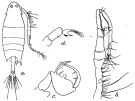 Issued from : R.B.S. Sewell in Mem. Indian Mus., 1932, X (continued). [p.373, Fig.124].. Male (from N Indian): a, habitus (dorsal); b, grasping A1; c, right P5; d, left P5.
|
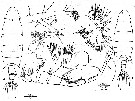 issued from : P.P. Pillai in J. mar. biol. Ass. India, 1971, 13 (1). [p.74, Fig.5, a-f, h]. Female (from Bombay waters): a, habitus (dorsal): b, A2; c, Md; d, Mx2. Male: f, habitus (dorsal); h, right A1.
|
 issued from : P.P. Pillai in J. mar. biol. Ass. India, 1971, 13 (1). [p.75, Fig.6]. Female: a-f, variations in genital segment and P5 in six adults. a-b: from Gulf of Mannar; c-e: from Cochin; f: from Bombay.
|
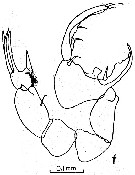 issued from : P.P. Pillai in J. mar. biol. Ass. India, 1971, 13 (1). [p.73, Fig.4, f]. Male: f, P5.
|
 issued from : R.B. Seymour-Sewell Rec. Indian Mus., 1912, 7 (4). [Pl.XXIII];
Female: 8, P5 (After Cleve, 1903-04): P5; 9, P5 (from Burma: 14°41,5'N, 97°53'E).
|
 issued from : A. Fleminger, B.H.R. Othman & J.G. Greenwood in J. Plankton Res., 1982, 4 (2). [Fig.4, K-L). Female: K-L, posterior part of prosome and urosome (lateral and dorsal, respectively).
|
 issued from : A. Fleminger, B.H.R. Othman & J.G. Greenwood in J. Plankton Res., 1982, 4 (2). [Fig.5, E). Female: E, P5 (posterior view).
|
 issued from : A. Fleminger, B.H.R. Othman & J.G. Greenwood in J. Plankton Res., 1982, 4 (2). [Fig.6, I-J). Male: I-J, posterior part of prosome and urosomal segments 1-3 (lateral and dorsal, respectively).
|
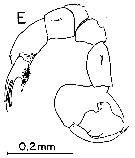 issued from : A. Fleminger, B.H.R. Othman & J.G. Greenwood in J. Plankton Res., 1982, 4 (2). [Fig.7, E). Male: E, P5 (posterior view).
|
 issued from : A. Fleminger, B.H.R. Othman & J.G. Greenwood in J. Plankton Res., 1982, 4 (2). [Fig.8, E). Male: E, right A1 (dorsal view).
|
 issued from : Mulyadi in Treubia, 2002, 32; [p.59, Table 2]. Characteristics features of L. pectinata in Indo-West Pacific. Comparison with L. detruncata, L. kroyeri and L. minuta (see at these species).
|
 issued from : B.H.R. Othman & T. Toda in Coastal Mar. Sc., 2006, 30 (1). [p.313, Fig.14]. Female (from Sister's Island, Singapore): A-B, habitus (dorsal and lateral, respectively); C-D, posterior part of prosome and urosome (lateral and dorsal); E, P5. Nota: Prosome to urosome length ratio 3.25 : 1. - Body elongated ending in a single spiniform process. Right and left thoracic process symmetrical. - Cephalon separated from pedigerous somite 1. - Cephalic hooks and small dorsal eye lens present. - A1 symmetrical exyends to the genital segment. - Urosome 3-segmented. - Right distal end of genital segment with unequal lateral spurs. - Distal end of 2nd urosomite with dorsal tubercle on right side, extending posteriad over anal segment. - P5 asymmetrical,; right leg slightly longer than left; right exopod with one medial, 1oneterminal and one lateral spiniform processes; endopod with 7 denticles; left leg exopod with 2 lateral denticles; left exopod with 2 lateral denticles, one lateral spiniform process and terminating in an attenuated spiniform process.
|
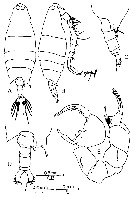 issued from : B.H.R. Othman & T. Toda in Coastal Mar. Sc., 2006, 30 (1). [p.313, Fig.15]. Male (from Sister's Island, Singapore): A-B, habitus (dorsal and lateral, respectively); C-D, posterior part of prosome and urosome (lateral and dorsal, respectively); E, P5. Nota: Prosome to urosome length ratio 3.33 : 1. - Body same as female but cephalic hooks, dorsal eye lens larger than females and contiguous. - Right A1 geniculate extending beyond anal segment when extended, villiform teeth on segments 18-21. - Right thoracic corner expanding horizontally, distally ending in lateral spiniform process and a medial process. - Genital segment with short acicular process not reaching middle of urosomite segment 2. - P5 with apical segment of left leg with medio-distal spur separated from cluster of 3 spiniform and 2 setiform processes by wide shallow notch; right leg with lamelliform process on proximal chelate segment, distal margin rounded and skewed toward thumb.
|
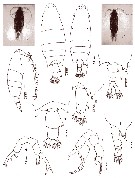 issued from : N. Phukham in Species diversity of calanoid copepods in Thai waters, Andaman Sea (Master of Science, Univ. Bangkok). 2008. [p.164, Fig.38]. Female (from W Malay Peninsula): a-b, habirtus (dorsal and lateral, respectively); c; urosome (dorsal); d, same (oblique right lateral view); e, P5. Male: f, habitus (dorsal); g, urosome (dorsal); h, same (lateral); i, P5. Body length after the drawings: F = 1.689 mm (urosome curved); M = 1.533 mm.
| | | | | Ref. compl.: | | | Krishnaswamy, 1953 (p.135); Wellershaus, 1969 (p.263, occurrence); Patel, 1975 (p.660); Stephen & Iyer, 1979 (p.228, tab.1, 3, 4, figs.3, 4); Sreekumaran Nair & al., 1981 (p.493), Madhupratap & Haridas, 1986 (p.105, tab.1); Fleminger, 1986 (p.84, figs. 7, 8, Rem.: geographic vs Wallace's Line); Gajbhiye & al., 1991 (p.189); Gajbhiye & Abidi, 1993 (p.137); Ramaiah & al., 1996 (p.3); Ramaiah & Nair, 1997 (tab.1); Achuthankutty & al., 1998 (p.1, Table 2, seasonal abundance vs monsoon); Mauchline, 1998 (tab.8); Dalal & Goswami, 2001 (p.22, fig.2); Rezai & al., 2004 (p.489, tab.2); Kazmi, 2004 (p.228): Rakhesh & al., 2006 (p.93, Table 2, spatial distribution); Madhu & al., 2007 (p.54, Table 4, abundance vs monsoon); Shanthi & Ramanibai, 2011 (p.132, Table 1); Varadharajan & Soundarapandian, 2013 (p.2: occurrence vs stations); Rakhesh & al., 2013 (p.7, Table 1, abundance vs stations); Jagadeesan & al., 2013 (p.27, Table 3, seasonal distribution); Anjusha & al., 2013 (p.40, Table 3, abundance & feeding behavior) | | | | NZ: | 2 | | |
|
Carte de distribution de Labidocera pectinata par zones géographiques
|
| | | | | | | | |  issued from : C.T. Achuthankutty, N. Ramaiah & G. Padmavati in Pelagic biogeography ICoPB II. Proc. 2nd Intern. Conf. Final report of SCOR/IOC working group 93, 9-14 July 1995. Workshop Report No. 142, Unesco, 1998. [p.8, Fig.6]. issued from : C.T. Achuthankutty, N. Ramaiah & G. Padmavati in Pelagic biogeography ICoPB II. Proc. 2nd Intern. Conf. Final report of SCOR/IOC working group 93, 9-14 July 1995. Workshop Report No. 142, Unesco, 1998. [p.8, Fig.6].
Salinity ranges for L. pectinata in coastal and estuarine waters of Goa (India).
Shaded area indicates the range of higher abundance. |
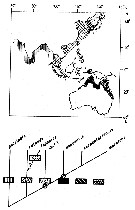 Issued from : A. Fleminger in UNESCO Techn. paers mar. Sci., 1986, 49. [p.92, Fig.7]. Issued from : A. Fleminger in UNESCO Techn. paers mar. Sci., 1986, 49. [p.92, Fig.7].
Present geographical distribution of the Labidocera pectinata species group., based on localities cited in Fleminger & al. (1982) and new unpublished data.
Extent of shading offshore is merely for illustrative purposes and not intended to depict actual offshore distribution of individual species; in most cases offshore distribution is confined to waters inshore of the 100 m isobath.
Cladogram in lower shows hypothetized phylogenetic relationships of species and shadings representing ranges of individual species.
Circled nodes are hypothetized speciation events taht appear to have occurred in the vicinity of Wallacea Line. |
| | | | Loc: | | | Arabian Sea, Karachi, Sri Lanka (Palk Straits), Laccadive Is., India (W, Cochin Backwater, off Cochin, Saurashtra coast, Bombay, Goa, Kerala, Pointcalimere-Mnamelkudi, Madras, Burhabalanga estuary), E India, Gulf of Mannar, Palk Bay, Godavari region, Bay of Bengal, Andaman Sea, W Malay Peninsula, Malaysia (Riv. Kurau), Straits of Malacca, Singapore, Mersing (South China Sea) | | | | N: | 31 | | | | Lg.: | | | (44) M: 1,7; (77) F: 2,1; (256) F: 2,1-1,91; M: 1,73-1,6; (269) F: 2,13-2,06; M: 1,79; (334) F: 2,1; M: 1,7; (530) F: 2; M: 1,5; (795) F: 2; (1086) F: 1,84-2,15; M: 1,58-2,03; {F: 1,84-2,15; M: 1,50-2,03} | | | | Rem.: | ± brackish.
Voir aussi les remarques en anglais | | | Dernière mise à jour : 11/05/2019 | |
|
|
 Toute utilisation de ce site pour une publication sera mentionnée avec la référence suivante : Toute utilisation de ce site pour une publication sera mentionnée avec la référence suivante :
Razouls C., Desreumaux N., Kouwenberg J. et de Bovée F., 2005-2025. - Biodiversité des Copépodes planctoniques marins (morphologie, répartition géographique et données biologiques). Sorbonne Université, CNRS. Disponible sur http://copepodes.obs-banyuls.fr [Accédé le 29 août 2025] © copyright 2005-2025 Sorbonne Université, CNRS
|
|
 |
 |

















